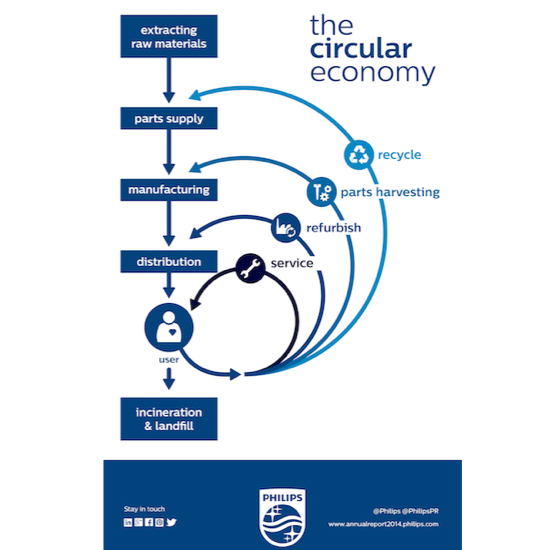 |
| Reviews and Templates for Expression We |
The Profitable Shift to a Circular Economy

A linear economy, where natural resources are extracted from the ground, made into products and then thrown away at the end of their useful life, is becoming increasingly unsustainable — and expensive for businesses.
Commodity prices rose more than 150 percent, between 2002 and 2010, according to the World Economic Forum.
“If we continue with the business-as-usual approach, companies and society will witness a probable surge in price volatility, inflation of key commodities, and an overall decline — and in some cases, depletion — of critical material inputs,” writes the US Chamber of Commerce Foundation’s Jennifer Gerholdt, environmental program director, in a new report.
The solution, according to the report, is the circular economy. In this model, raw materials are extracted and made into products that are designed and manufactured for reuse and remanufacturing or recycling. It conserves natural resources and aims to eliminate waste.
Increase Competitiveness, Boost Sales
Many companies are already implementing a circular economy model and major players, including Google and Dell are partnering with the Ellen MacArthur Foundation on closed-loop initiatives. These firms see the circular economy not only as a way to reduce waste and improve sustainability performance, but also increase competitiveness, new product development and overall sales.
Dell’s closed-loop recycled plastics supply chain, for example, which has seen the company recycle 4.2 million pounds of closed-loop plastics into enclosures for new Dell products. And Tetra Pak is using circular economy principles in sourcing materials at the beginning of a package’s lifecycle, this week making the world’s first fully renewable package available to customers worldwide.
In the US Chamber’s report, produced in partnership with the Ellen MacArthur Foundation, The Chamber showcases a series of best practices and for how companies are leveraging the environmental, economic, and social opportunities the circular economy provides — how they are doing it profitably.
$4.5 Trillion Additional Economic Growth
“A shift from a linear to a circular economy could unlock an estimated $4.5 trillion in additional economic growth by 2030,” Gerholdt tells Environmental Leader. “The circular economy has captured the imagination of many companies that see the economic innovation opportunities of this more restorative model to tackle sustainability challenges, drive performance, competitiveness and innovation, and stimulate economic growth and development.”
In the Ethical Corporation’s 2015 Circular Economy report, Nellie Cohen, worn wear coordinator at Patagonia, says that the company has long recognized that the “take, make, dispose” economy is not viable. “We could see that it is going to drive environmental degradation so far that we would have to continue to work harder and harder to extract the natural resources we need to make stuff. So it’s about whether we as a world decide to introduce a more circular model or just continue to progress down a dead-end path.”
The report outlines how individual businesses can profit from the circular economy and how they can make the shift to a more circular model. “Organizations that reposition their business model towards the circular economy can expect to enjoy greater stability and efficiency among their supply chains; cost savings from the reduction in waste and resource use; and reputational enhancement from increased brand awareness and loyalty,” it says.
Closing the Loop
“The circular economy aims to develop closed-loop business systems that enables economic growth whilst decoupling it from resource consumption. Circular economy business models, such as leasing, allow full traceability of materials and enables the business to keep hold of its resources,” Nichola Mundy, senior consultant at Axion Consulting, tells Environmental Leader.
Earlier this week Axion Consulting announced it has partnered with Philips, a supplier of medical imaging systems and therapy devices and a global partner of the Ellen MacArthur Foundation, on a research project into how UK hospitals could benefit from alternative business models for refurbished high-value medical imaging and ultrasound equipment, offering potentially large savings.
The six-month “CircMed” project, co-funded by the UK’s innovation agency, Innovate UK will explore how the proposed circular economy business models for supplying refurbished equipment can work within the UK healthcare sector. The feasibility study focuses on a range of medical imaging equipment, including MRI scanners, ultrasound equipment, CT scanners, interventional X-ray equipment and mobile surgery.
Mundy says the “ambitious” project could have a “significant impact” on the UK healthcare sector, allowing for a more sustainable future while also increasing the affordability of vital diagnostic equipment for UK hospitals.
Raw Material Preservation
An added important benefit would be the preservation of significant amounts of critical raw materials, such as Gallium in LCD screens and integrated circuits, Beryllium in CT scanners and Niobium superconducting magnets and Helium for MRI scanners.
There’s a strong economic case for the circular economy. But as the World Economic Forum’s Dominic Waughray writes in the organization’s 2014 Towards the Circular Economy report, the economic gain can only be realized if multiple businesses, supported by policy makers, make the transition away from a linear model: “A large-scale, business-led collaboration is required.”
|
|
|
|
Copyright 2011 Energy and Technical Services Ltd. All Rights Reserved. Energyts.com |